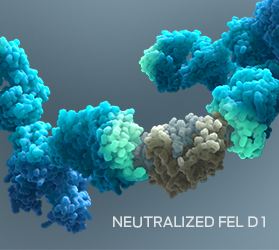Landmark Purina Study: Pivotal Step Towards Reducing Cat Allergens

Allergies to cats are the most common animal-origin allergies in humans1 and affect approximately 1 in 5 adults worldwide.2
Cat owners may be encouraged to avoid contact with their cat on an allergist’s recommendation, but often go to great lengths to keep their cat. At the very least, they may be forced to spend less time with their cat. They will often have to exclude their cat from the bedroom and take medications to try to manage their allergic symptoms.
Cat allergies can also be a barrier to cat ownership by preventing adoption and potentially leading to cat rehoming or relinquishment.3-6 This is why Purina scientists have dedicated more than 10 years to researching how to manage cat allergens and improve the lives of cat lovers and their feline companions.
Watch the video and explore how we are addressing the problem
Purina's research

Purina scientists discovered that an egg product ingredient containing antibodies to Fel d 1, the major cat allergen, can bind to Fel d 1 in the cat’s saliva, preventing its ability to trigger an allergic response in a cat allergen-sensitized individual.
This discovery may lead to novel and exciting approaches for managing cat allergens, while maintaining the normal production of Fel d 1 by the cat and without impacting the cat’s overall physiology. These breakthrough findings can transform how people manage allergies to cats while keeping the cat in the home.
Watch the video that summarizes this breakthrough discovery
Find out more about this discovery, and what this could mean for the lives of cats and the people who care for them:
Find out more
1. Morris, D. (2010). Human allergy to environmental pet danders: A public health perspective. Veterinary Dermatology, 21, 441-449.
2. Bousquet, P.-J., Chinn, S., Janson, C., Kogevinas, M., Burney, P. & Jarvis, D. (2007). Geographical variation in the prevalence of positive skin tests to environmental aeroallergens in the European Community Respiratory Health Survey I. Allergy, 62, 301-309.
3. American Humane Association. (2012). Keeping pets (dogs and cats) in homes: A three-phase retention study. Phase I: Reasons for not owning a dog or cat. Retrieved from the American Humane Association website: https://www.americanhumane.org/app/uploads/2016/08/aha-petsmart-retention-study-phase-1.pdf
4. Casey, R.A., Vandenbussche, S., Bradshaw, J.W.S., & Roberts, M.A. (2009). Reasons for relinquishment and return of domestic cats (Felis silvestris catus) to rescue shelters in the UK. Anthrozoös, 22, 347-358. doi: 10.2752/089279309X12538695316185
5. Coe, J.B., Young, I., Lambert, K., Dysart, L., Borden, L.N. & Rajic, A. (2014). A scoping review of published research on the relinquishment of companion animals. Journal of Applied Animal Welfare Science, 17, 253-273. doi: 10.1080/10888705.2014.899910
6. Zito, S., Morton, J., Vankan, D., Paterson, M., Bennett, P.C., Rand, J., Phillips, C.J.C. (2016). Reasons people surrender unowned and owned cats to Australian animal shelters and barriers to assuming ownership of unowned cats. Journal of Applied Animal Welfare Science, 19, 303-319. doi: 10.1080/10888705.206.1141682




